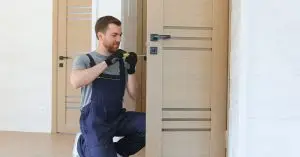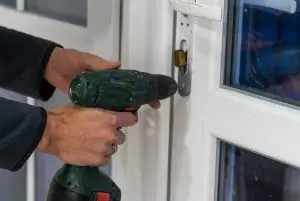Smart homes are no longer futuristic concepts. They are now part of everyday life in Calgary households. Lights, cameras, thermostats, and even coffee machines can be controlled from a single device. But for all the convenience these systems bring, security remains their foundation. Integrating locks with smart home ecosystems allows us to combine safety with simplicity. It helps us manage entry, monitor activity, and respond quickly when something changes.
Understanding the Role of Smart Locks in Home Security
Smart locks replace or upgrade traditional mechanical locks with digital features that communicate with your home network. Once installed, they can connect to Wi-Fi, Bluetooth, or a smart home hub, allowing us to control doors remotely or automate their behavior. For example, the door can lock itself at night or when everyone leaves the house.
What makes this system effective is the link between convenience and awareness. We no longer depend on keys alone. We can unlock the door with a phone, assign access codes to guests, or check whether the door is secure while we’re away. These features strengthen both security and daily comfort.
If you’re just starting to explore this technology, it helps to speak with a professional who understands both traditional locking systems and new digital tools. A local locksmith in Calgary can evaluate which locks fit your doors, network setup, and level of security.
Choosing the Right Type of Smart Lock
Every smart lock operates differently. Some replace the entire lock mechanism, while others adapt existing hardware. When we choose one, we need to balance convenience, security, and compatibility.
- Full Replacement Locks connect directly to the door frame and offer the highest level of integration. They typically include built-in Wi-Fi or Zigbee connectivity and work well in complete smart home systems.
- Retrofit Models attach to the existing deadbolt from the inside. They are easier to install and ideal for renters or homeowners who want an upgrade without changing keys.
Battery life also matters. Most smart locks use standard batteries that last between six months and a year. Look for one with clear alerts when power is low. This prevents getting locked out due to an unexpected failure.
Finally, check compatibility with your chosen platform. Some locks work best with Google Home or Alexa, while others integrate seamlessly with Apple HomeKit. Matching your lock to your ecosystem ensures smooth communication and automation.
Integration with Smart Hubs and Voice Assistants
A smart lock becomes most useful when it’s part of a larger system. Hubs and voice assistants like Alexa, Google Home, or Apple HomeKit serve as the bridge between devices. Through them, we can set up routines or triggers. For example, when we say “Goodnight,” the assistant can lock the doors, turn off the lights, and arm the alarm.
However, before connecting everything, it’s important to verify encryption and access controls. Many people forget that the same connectivity that enables convenience can also open a digital doorway. Always set up unique passwords and enable two-factor authentication whenever possible.
Using a dedicated home automation app gives us central control over security and convenience. It helps monitor the door’s status, create time-based access schedules, and integrate the lock with motion sensors or doorbell cameras.
Maintaining Security While Expanding Connectivity
Connecting locks to smart networks introduces new responsibilities. A connected device must stay updated to remain secure. Firmware updates from the manufacturer often fix vulnerabilities or add new features. Regularly checking for updates ensures your smart lock performs safely.
Another important step is network management. Keep smart devices on a separate Wi-Fi network from personal computers. This isolates them from sensitive data and reduces exposure to potential cyberattacks.
While convenience is valuable, always maintain manual backup access. Many smart locks still allow key entry or backup codes. Store them safely but separately from the main system. This small habit can save time in emergencies such as power outages or connection failures.
Automating Everyday Routines for Safety and Comfort
One of the main advantages of integrating locks with smart home systems is automation. A door can automatically lock when your phone leaves a certain area or unlock as you approach. This eliminates the need to remember and reduces human error.
For families with children, automation brings peace of mind. Notifications can alert you when the kids arrive home or if the door remains unlocked. These small updates prevent anxiety and help coordinate household routines.
In multi-resident homes or properties with frequent visitors, temporary access codes make life easier. You can set expiration times for cleaners, guests, or contractors without handing over a permanent key. When their access period ends, the code stops working, keeping control in your hands.
To ensure automation features perform correctly, professional installation makes a difference. Setting up wiring, calibration, and system integration requires precision. For advice or installation support, you can review options like lock installations in Calgary.
Combining Locks with Security Cameras and Sensors
Smart locks reach their full potential when paired with other devices. Cameras, motion sensors, and doorbell systems extend awareness beyond the lock itself. Together, they build a layered security system.
For example, when the lock opens, the camera can automatically record the event. This helps identify who entered and when. If the lock detects forced entry or an unusual pattern, the system can send an instant alert to your phone.
Sensors near doors can also trigger lighting. When you arrive home after dark, the lights turn on automatically, improving safety and comfort.
The goal is not just control but context. A connected lock is one piece in a web of information that helps you understand what’s happening around your home at all times.
Managing Guest and Remote Access Responsibly
Remote access features allow us to unlock doors from anywhere. While this is practical, especially for deliveries or family members, it requires caution. Always verify who requests access before approving it remotely. Some apps let you view live video before unlocking, adding a layer of protection.
In rental or shared properties, set clear policies for temporary users. Avoid reusing old codes and monitor the system logs to track activity. Many smart locks allow viewing entry history directly from the app, which helps identify irregular patterns.
Teaching every household member how to use the system safely is equally important. Ensure that children and guests understand the difference between temporary and permanent access. Good digital habits prevent confusion and maintain trust.
Troubleshooting Common Integration Issues
Even with modern technology, small issues can arise. A common challenge is connectivity. If the lock loses connection, restart your router or check for interference from nearby devices. Some locks require specific frequency bands, so verify the router’s settings match.
Battery drain is another frequent issue. High-traffic doors use more power, and frequent wireless communication can shorten battery life. Consider adjusting how often the lock reports its status to the hub.
When the system behaves unpredictably, such as failing to lock automatically or showing false alerts, resetting both the lock and the hub often resolves the problem. Save configuration settings first to avoid losing schedules or access codes.
If the problem continues, professional evaluation can save time. A locksmith familiar with both digital and mechanical systems can identify whether the issue lies in the hardware, software, or installation.
The Future of Connected Security
Smart locks continue to evolve. Newer models use advanced encryption and integrate with broader systems such as home energy management and emergency services. As technology progresses, our role shifts from constant manual control to smart supervision.
Homes of the future will likely combine data from multiple devices to predict needs. If the system detects that everyone has left, it could lock the doors, lower the thermostat, and activate security without being asked.
However, technology should remain a tool, not a dependency. Balancing automation with awareness keeps us in control. Even the most advanced smart home works best when its owner understands how each part functions and communicates.
For homeowners considering upgrades or first-time installations, professional input ensures every component aligns correctly. You can contact us for tailored advice or setup assistance. A short consultation can prevent costly mistakes and provide lasting peace of mind.
Frequently Asked Questions
How do I know if my current door is suitable for a smart lock?
Most doors can accommodate smart locks, but the exact fit depends on the type of deadbolt and spacing. A professional can measure and confirm compatibility before installation.
Can smart locks still work during power outages?
Yes. Most smart locks operate on batteries, so they continue functioning when the power goes out. Some even include mechanical key options as a backup.
Are smart locks safe from hacking?
Modern smart locks use encryption similar to that in online banking. Keeping firmware updated and using strong passwords greatly reduces any risk.
What happens if my Wi-Fi connection drops?
The lock can still be operated through Bluetooth or manually. Once the connection returns, the system syncs and updates all actions performed while offline.
Is professional installation necessary?
While many models support DIY installation, professional setup ensures full functionality, secure calibration, and reliable integration with your smart home system.





